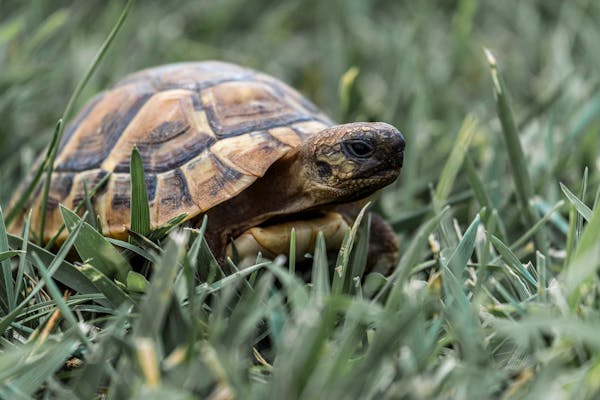Have you seen turtle holes in your yard and wondered where they came from? It’s likely turtles are making them. They dig these holes to lay their eggs, which can sometimes clash with our tidy lawns.
It’s important to understand why turtles dig these holes and how to handle them while still supporting wildlife.
What exactly are these turtle holes, and how do they differ from other animal burrows?
It’s also key to know how to protect these turtle nests while keeping your yard looking great. Let’s explore this guide to learn more and appreciate the turtles in your yard.
What Are Turtle Holes?
Turtle holes are where turtles lay their eggs in yards and gardens. They look like shallow, bowl-shaped holes in the ground. The soil is pushed up around the edges. To spot these holes, look for their unique shape and signs of turtle tracks nearby.
Identifying Turtle Nest Holes in Your Yard
Here’s how to find turtle nest holes in your yard:
- Look for shallow, bowl-shaped holes in the soil, about 3-4 feet wide.
- Check for mounded soil around the hole’s edges.
- See if you can spot turtle tracks going to and from the hole.
- Notice if the soil in the area looks disturbed.
- Distinguishing Turtle Holes from Other Animal Burrows
- It’s key to tell turtle holes apart from other animal burrows. Here’s how:
- Armadillo holes are small, 1-3 inches deep, and 3-5 inches wide, with sandy soil mounds nearby.
- Gopher tortoise burrows have wide entrances, 6-12 inches in diameter, with sandy mounds.
- Vole burrows are tiny, with 1-2 inch wide entrances, and often have runways and vegetation piles.
- Mole tunnels are underground, with no visible entrance or soil mound.
Knowing what turtle holes look like helps you spot them and tell them apart from other burrows in your yard.
Turtle Holes in Yard
As the weather gets warmer, you might see small holes in your yard. These are probably made by nesting turtles. Turtles, like snapping turtles, come onto land to dig nests and lay eggs in safe spots. Your yard might seem like a good place for them.
Why Turtles Dig Holes in Your Lawn
Turtles like the soft, loose soil in your lawn for nesting. They dig shallow holes, about 4-6 inches deep, to lay their eggs. This is because they want to protect their eggs and ensure their babies’ survival.
Seasonal Patterns of Turtle Nesting Activities
The timing of turtle nesting follows the seasons. They come out of the water and look for nesting spots in spring and summer. Female turtles dig nests and lay eggs from May to July. The eggs stay in the nest for 9 to 18 weeks before the baby turtles hatch.
Knowing why turtles dig holes and when they do can help you live with them peacefully. By understanding seasonal wildlife patterns, you can protect turtle nests and keep your yard safe.
Protecting Turtle Nests
When turtles nest in your yard, it’s key to protect their eggs and hatchlings. This helps the local turtle population and supports conservation. By using protective steps, you can help these amazing reptiles hatch and survive.
To protect turtle nests, fence off the area:
- Use a small wire mesh or plastic fence that’s securely anchored. This keeps predators like raccoons and skunks away from the eggs or hatchlings.
- Don’t disturb the nest. Avoid digging or checking if eggs are inside. This can hurt the developing hatchlings. Watch the nest from afar and look for signs of predators or hatchlings.
- Fence off the nesting area with a wire mesh or plastic barrier to deter predators.
- Avoid disturbing the nest, as this can harm the developing hatchlings.
- Monitor the nest for any signs of predator activity or hatching success.
- Work with local wildlife agencies or conservation groups for the best ways to protect turtle nests. They can suggest techniques, like nest cages or other structures for your area’s turtle species.
Protecting turtle nests helps these creatures and your local ecosystem. Your efforts in caring for the environment make a big difference for turtles in your area and beyond.
Conclusion: Impact on Your Yard
Turtle holes in your yard show healthy local wildlife. But, they can also cause problems for homeowners. Turtles digging and nesting can damage your lawn, making it look bad and hard to care for. Turtle holes make lawn care tough.
The soil gets disrupted, making it hard to mow and maintain your lawn. You might need to change how you take care of your lawn because of these turtle nests. Turtle holes can be dangerous, especially for people and pets. They can trip you up if you’re not careful. It’s important to manage these holes well.
But, you can live with turtles and lessen the yard damage. By understanding turtle nesting and taking steps to fix problems, you can make your yard safe and fun for everyone. This way, you and the turtles can get along.
FAQs
Q: Why do I have turtle holes in my yard?
A: If you find turtle holes in your yard, it could be due to terrestrial turtles looking for nesting sites to lay eggs in the soil.
Q: What type of turtles dig holes in yards?
A: Various species of turtles, such as box turtles or snapping turtles, may dig and bury holes in yards to nest or lay their eggs.
Q: How can I prevent turtles from digging in my yard?
A: To prevent turtles from digging in your yard, you can create a safe and secure enclosure or use chicken wire to keep them away from the nest area.
Q: What time of year do turtles lay their eggs?
A: Turtles typically lay their eggs in late spring or early summer when the weather is warmer and the soil is suitable for incubation of hatchling turtles.
Q: Can I relocate turtle eggs found in my yard?
A: It’s advisable to contact your local county extension office for guidance on how to safely relocate turtle eggs to a more suitable habitat.
Q: Are there any predators that may disturb turtle nests in yards?
A: Predators like raccoons are known to search for turtle nests to predator on the eggs or hatchlings within.
Q: How do female turtles create nesting sites in yards?
A: Female turtles use their hind legs to dig a suitable hole in the soil to create a nest site for depositing their eggs.



